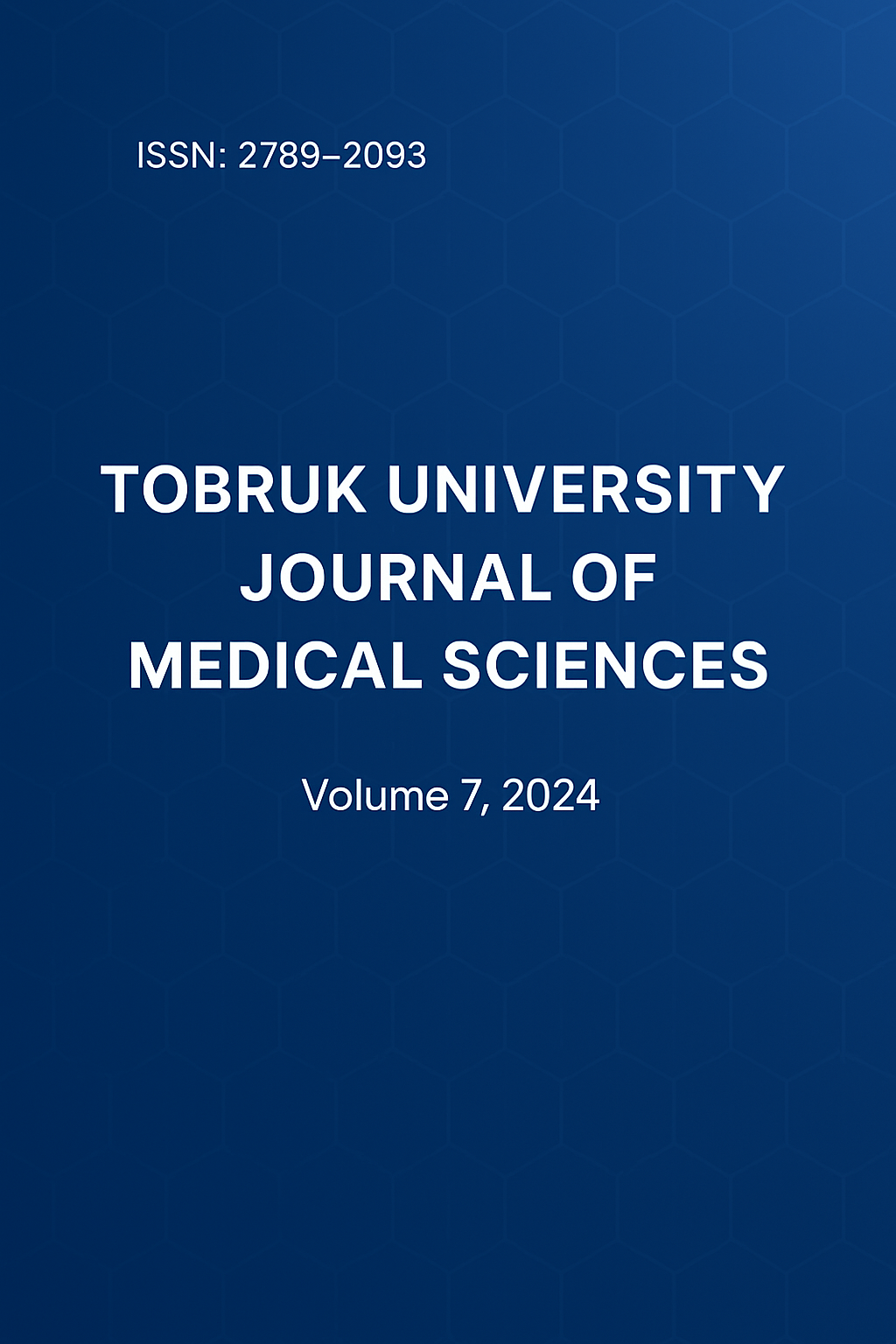Sensitivity and Resistance Patterns of Urinary Tract infections.
DOI:
https://doi.org/10.64516/k7mgnn84Keywords:
Urinary tract infections (UTI), bacteria, disc diffusion method, Antibiotic sensitivity / resistance drugs.Abstract
Objectives: To identify the most common bacteria causing urinary tract infections (UTI) and their sensitivity and resistance patterns for some antimicrobial agents. Methodology: A total of 773 cases from outpatients and inpatients attended Al-Wahda therapeutic and teaching hospital, Derna - Libya, clinically suspected as having UTI during 2021 and 2022, were examined for microbiological and pattern of antibiotic susceptibility by disc diffusion method. Results: By using direct smear microscopy and routine culture methods, different bacterial species were isolated from only 262 (33.9%), the remaining 511 (66.1%) of cases showed no bacterial growth. Bacteriological examination of urine showed that Escherichia coli was found in 106 (40.4%) of cases, Klebsiella in 59 (22.5%), Staph. epidermidis in 35 (13.3%), Staph. aureus in 32 (12.2%), Proteus spp. in 12 (4.5%), Pseudomonas in 8 (3%), Enterococci in 6 (2.3%), and Corynebacteria in 4 (1.5%) of cases. The antimicrobial sensitivity pattern in the treatment of UTIs indicated that the Ciprofloxacin shows (80.2% sensitivity) , Amoxicillin (70.2%), Nitrofurantoin (64.5%), and Ceftriaxone (61.8%). Meanwhile, for treating UTI produced by Enterococci, the antimicrobial drug of choice is Amoxicillin (70.2% sensitivity), Nalidixic acid (60.3% sensitivity), and Ampicillin (9.2% sensitivity), while for treating Pseudomonas spp, the drug of choice should be member of Fluoroquinolones group as Ciprofloxacin (80.2% sensitivity), and Sulfamethoxazole plus Trimethoprim (26.3% sensitivity). Conclusion: Urinary tract infection is a major cause of morbidity, especially in young children. Trends in choice of antibiotic treatment may change depending on locally determined resistances, common pathogens, and cost issues.
References
1. Mitchell, E. D., Murray, C. C., Meads, D., Minton, J., Wright, J., & Twiddy, M. (2017). Clinical and cost-effectiveness, safety and acceptability of community intravenous antibiotic service models: CIVAS systematic review. Bmj Open, 7(4), e013560.
2. Sanchez, G. V., Fleming-Dutra, K. E., Roberts, R. M., & Hicks, L. A. (2016). Core elements of outpatient antibiotic stewardship. Morbidity and Mortality Weekly Report: Recommendations and Reports, 65(6), 1-12.
3. Harbarth, S., Balkhy, H. H., Goossens, H., Jarlier, V., Kluytmans, J., Laxminarayan, R., ... & Pittet, D. (2015). Antimicrobial resistance: one world, one fight!.
4. Ibrahim, E. H., Sherman, G., Ward, S., Fraser, V. J., & Kollef, M. H. (2000). The influence of inadequate antimicrobial treatment of bloodstream infections on patient outcomes in the ICU setting. Chest, 118(1), 146-155.
5. National Collaborating Centre for Women's and Children's Health (UK. (2007). Urinary tract infection in children: diagnosis, treatment and long-term management.
6. Leung, A. K., Wong, A. H., Leung, A. A., & Hon, K. L. (2019). Urinary tract infection in children. Recent patents on inflammation & allergy drug discovery, 13(1), 2-18.
7. Jadresic, L., Cartwright, K., Cowie, N., Witcombe, B., & Stevens, D. (1993). Investigation of urinary tract infection in childhood. British Medical Journal, 307(6907), 761-764.
8. Klein, R. S. (1994). Criteria for the diagnosis of urinary tract infection. Current Opinion in Nephrology and Hypertension, 3(6), 652-655.
9. Wammanda R.D., Ewa B.O. Urinary tract pathogens and their sensitivity pattern in children. Annals of Tropical Pediatrics 2002;22:197-8.
10. Arslan S, Caksen H, Rastgeldi L, Uner A, Oner AF, Odabas D. Use of urinary gram stain for the detection of urinary tract infection in childhood. Yale Journal of Biology and Medicine 2002;75:73-8.
11. Saleh SI, Tuhmaz MM, Sarkhouh MY, El-Ghawabi MA. Urinary tract infection in children in Al-jahra area, Kuwait: An overview. Kuw Med J 2003;35(1):31-35.
12. Modarres S, Nassiri N. Bacterial etiologic agents of urinary tract infection in children in the Islamic Republic of Iran. East Mediterr Health J 1997;3(2):290-5.
13. Langley JM, Hanakowski M, Leblanc JC. Unique epidemiology of nasocomial urinary tract infection in children. Am. J. Infect. Control 2001;29:94–8.
14. Boscia JA, Kobasa WD, Knight RA et al. Epidemiology of bacteriuria in an elderly ambulatory population. Am J Med 1986; 80: 208–14.
Downloads
Published
Issue
Section
License
Copyright (c) 2024 Moftah El garba, Jalal A. Boderraha. (Author)

This work is licensed under a Creative Commons Attribution 4.0 International License.











